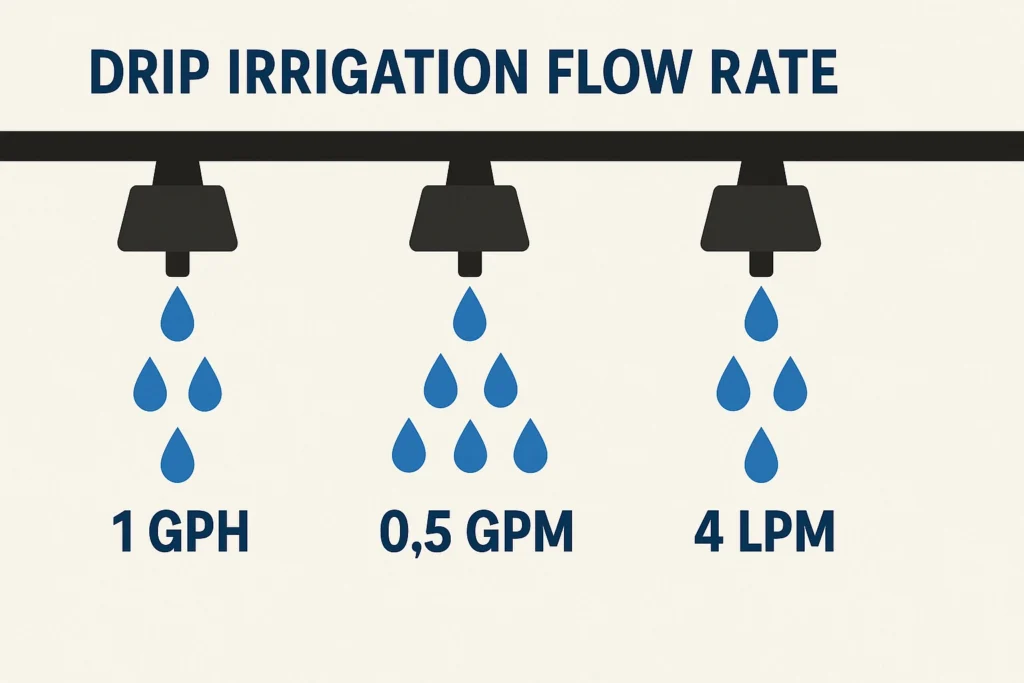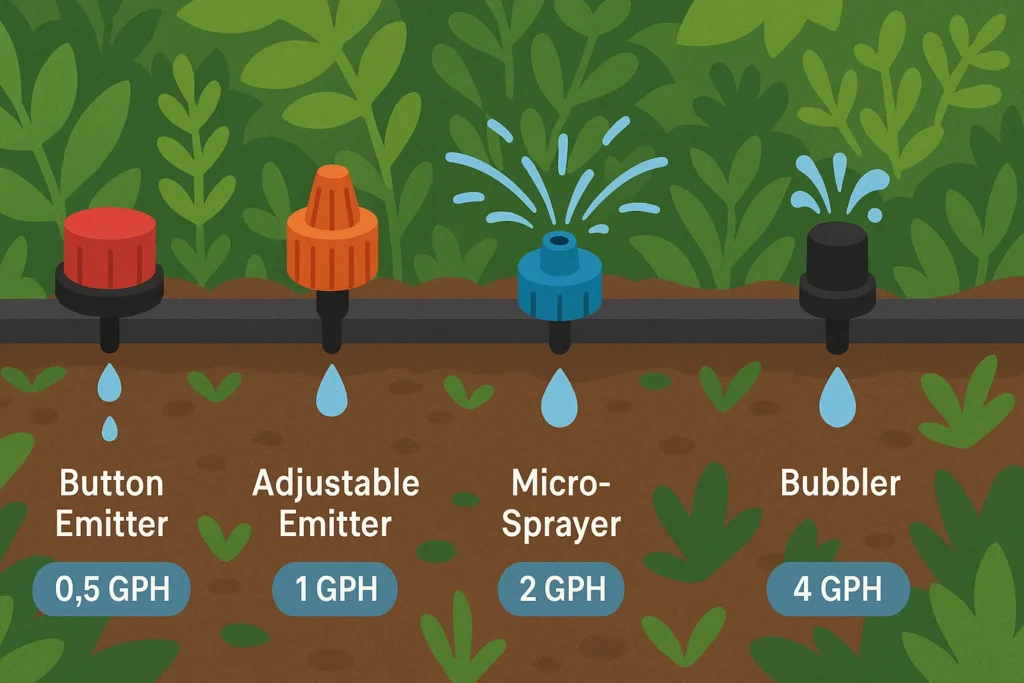🚰 Drip Irrigation Flow Rate Calculator
Calculate your system's water output and convert between GPH, GPM, LPM, and CFS.
Drip Irrigation Flow Rate Calculator: How to Measure GPH, GPM, LPM, and Even CFS

Created by James S. Lockwood
With a background in botany and ecological sciences, James specializes in creating practical tools and resources to help gardeners, farmers, and plant enthusiasts optimize their green spaces.
Choosing the right flow rate for your drip irrigation system isn’t just about plugging in numbers — it’s about understanding the rhythm of your landscape. Whether you’re managing a vegetable patch or an orchard, using a reliable drip irrigation flow rate calculator can make the difference between thriving plants and overwatered beds.
But not all flow rate calculators are created equal. Some offer gallons per hour (GPH), others display gallons per minute (GPM), and a few go as far as liters per minute (LPM) or cubic feet per second (CFS). Knowing when and how to use each measurement adds an extra layer of control — and confidence.

Table of Contents
How to Calculate Drip Irrigation Flow Rate?

The basic idea is simple:
Flow Rate = Emitter Rate × Number of Emitters
If you’re using 100 emitters rated at 1 GPH, your system delivers 100 gallons per hour. But what if you’re planning a pump or checking water pressure? That’s where GPM comes in.
Convert GPH to GPM by dividing by 60.
So 100 GPH = 1.67 GPM.
You can try this using our Drip Irrigation Flow Rate Calculator, which shows GPH and GPM side-by-side and even estimates the pump size you’d need.
Some growers believe flow rate isn’t as critical if they “just water long enough.” But that’s a risky assumption. Underestimating flow can lead to dry roots. Overestimating? Root rot or nutrient washout.
GPH vs GPM – Which One Should You Use?

GPH (gallons per hour) is perfect for emitter-level planning. If you know how much water a plant needs per day, calculating GPH ensures you don’t over- or under-water.
GPM (gallons per minute) helps when planning the system at scale — pumps, pressure regulators, filters, and pipe diameters are all typically rated in GPM.
Confusingly, some systems label emitters in GPH but specify pump requirements in GPM. It’s not wrong — just a different view of the same puzzle. Our Pump Calculator bridges the two with built-in conversion logic.
Convert GPM to LPM and CFS

You may not need LPM unless you’re working outside the U.S. — but if you are, remember:
1 GPM = 3.785 LPM
And if you’re sizing flood irrigation systems or calculating flow through open channels:
1 GPM = 1 ÷ 448.831 CFS
Sound technical? Maybe. But it’s useful. You don’t need to memorize these numbers — our Flow Rate Calculator displays GPM, LPM, and CFS automatically.
Some users prefer CFS for soil absorption comparisons. Others find it overkill. It depends on your setup. Ambiguity exists because gardening isn’t exact science — it’s a living equation.
Know your pressure? Convert from PSI to GPM here.
System Flow Rate Estimator (Interactive Tool)
Using the Drip Irrigation Flow Rate Calculator is simple:
Enter your emitter rate (e.g., 1 GPH)
Input number of plants and emitters per plant
Select your unit (GPH or LPH)
The calculator returns:
Total system flow (GPH & GPM)
Pressure needs (in PSI and Bar)
Suggested pipe diameter
Pump capacity with a 25% margin
Bonus: GPM to LPM and CFS conversions
If you’re also wondering how long to run your system once you know the flow rate, check out our Drip Irrigation Run Time Calculator.
Emitter Output, Pressure & Pipe Sizing Guide

How many emitters per plant is too many?
It depends. Some growers use two 0.5 GPH emitters per tomato. Others prefer a single 1 GPH emitter for consistency. And yes, emitter spacing matters — particularly in row crops or raised beds.
Low-flow emitters (0.5 GPH) are ideal for moisture-sensitive roots.
High-flow emitters (2–4 GPH) may be better for trees or clay soils with poor infiltration.
Once you know your total GPH, you can size your pipe using friction loss guidelines. But if that feels too technical, just let the calculator guide you. It suggests pipe sizes and calculates approximate PSI needs — you don’t need to overthink it.
For growers seeking a deeper understanding of friction loss, emitter flow classifications, and pipe hydraulics, the USDA’s Microirrigation Design Considerations guide offers an excellent technical reference used by irrigation engineers and extension specialists alike.
Other Drip Irrigation Calculators You Might Need
While our Drip Irrigation Run Time Calculator helps determine watering duration, you may also need these related tools:
- Drip Irrigation Calculator – A complete tool to calculate total water requirements for different plant types, climates, and soil conditions.
- Drip Irrigation Cost Calculator – Estimate the cost of setting up a drip irrigation system, including pipes, emitters, and installation.
- Drip Irrigation Run Time Calculator – Find out how long to run your drip irrigation system based on plant needs.
- Drip Irrigation Pump Calculator – Determine the right pump size and pressure requirements for an efficient drip irrigation setup.
Each of these calculators plays a crucial role in optimizing your irrigation system, ensuring your plants get just the right amount of water without waste.
FAQs About the Drip Irrigation Flow Rate Calculator
How do I calculate flow rate in drip irrigation?
To calculate the flow rate, multiply the number of emitters by the flow rate of each emitter in GPH (gallons per hour). For example, 100 emitters at 1 GPH = 100 GPH total. Divide by 60 to convert to GPM.
What is the difference between GPH and GPM?
GPH (gallons per hour) is ideal for measuring individual emitter output, while GPM (gallons per minute) is better for understanding total system flow, pump sizing, and pipe selection. Both are useful depending on context.
How do I convert GPM to LPM?
To convert gallons per minute (GPM) to liters per minute (LPM), multiply by 3.785. For example, 10 GPM = 37.85 LPM.
How do I convert GPM to CFS?
To convert GPM to CFS (cubic feet per second), divide the GPM value by 448.831. This is helpful for high-volume systems or open flow channels.
How many GPH emitters do I need per plant?
It depends on the plant and soil. Smaller plants may need 0.5–1 GPH, while trees or large shrubs may require 2–4 GPH or more. Consider the number of emitters and their placement too.
How to calculate flow rate for drip irrigation?
Multiply the emitter flow rate (GPH or LPH) by the number of emitters in the system. You can also use a Drip Irrigation Flow Rate Calculator for precision.
How many litres per hour is drip irrigation?
Most emitters range from 1 to 8 LPH. To convert from GPH to LPH, multiply by 3.785. For example, 2 GPH = 7.57 LPH.
What is the 30/30 rule for drip irrigation?
This general guideline suggests watering for 30 minutes, 3 times a week. It's a useful starting point but should be adjusted based on your crop, soil, and weather conditions.
What is the 200 rule for drip irrigation?
The 200 rule recommends that each irrigation zone stay under 200 GPH total flow. Going above this can lead to pressure drops and uneven water distribution.
How many drippers per line?
For 1/2" tubing, up to 200 drippers can typically be used. For 1/4" tubing, limit it to 10–15 drippers. Always account for pressure loss over long runs.
What is the normal rate of water application in drip irrigation?
Emitters generally apply water at 1–4 LPH (0.25–1 GPH). Ideal rates depend on plant type, soil structure, and climate. Lower rates are best for clay soils, while sandy soils may require higher outputs.
Final Thoughts
There’s no perfect formula — only good frameworks. Some growers swear by constant pressure regulators. Others adjust watering by season. What matters is consistency, not complexity.
A good drip irrigation flow rate calculator doesn’t just give you numbers — it gives you confidence. And that’s what good planning is about.
Disclaimer for Drip Irrigation Flow Rate Calculator
This Drip Irrigation Flow Rate Calculator provides estimates based on standard irrigation formulas. Results may vary depending on soil conditions, water pressure, and emitter efficiency. Always consult a professional for precise irrigation system design. We are not responsible for any discrepancies or misuse of this tool.
Discover Crop & Farming Calculators
